Public Commission: "Power over others is Weakness disguised as Strength, 2023": Orchard Place, The Broadway, Westminster, SW1H 0BG
Essay by Alexander Massouras
Power Over Others is Weakness Disguised as Strength, 2023
This sculpture brings together two unexpected images: a man on horseback and a curling line. These images can be seen from two axes perpendicular to one another, and from all other angles the images dissolve into something amorphous and abstract. The sculpture stands in the heart of Westminster, a seat of national power, where the cityscape is punctuated by numerous statues of men on horseback. Those monuments proclaim a kind of authority that this sculpture questions both through its unexpected meeting of two visual quotations and the honest visibility of its structure. Supporting ribs are clear to see, as is the welding that joins the steel. When its silhouettes become visible, one comes from a statue located outside the nearby Palace of Westminster. That reference is a celebratory depiction of King Richard I first unveiled in 1851, a period of rampant industrialisation and imperialism. From another angle, the sculpture becomes a linear squiggle printed almost a hundred years before that, in Laurence Sterne’s novel The Life and Opinions of Tristram Shandy, Gentleman (1759). In this fictional memoir, based on Miguel de Cervantes’s Don Quixote (1605), the printed line records a waving gesture made with a stick during a conversation, when a normally verbose character stops talking and instead communicates meaning physically. It is a wordless representation, both in that conversation and in the block of printed text describing what was (and was not) said.
The vital role of Laurence Sterne’s curling line in the sculpture, where it serves as a spine articulating the mass of steel, calls into question particular concepts of representation. Sterne’s novel famously foregrounds digression, interruption and the vagaries of narrative. How do we represent something permanently, like the meandering movement of a conversational gesture, and how does an idea transform when made material, fixed in ink or steel? Layers of history nuance these twenty-first century questions, filtering them through a nineteenth-century view of an eleventh-century king, and an eighteenth-century text. Its allusion to a novel makes the sculpture speak to storytelling and the spinning of narratives, calling up the fictions within monuments and the figures they memorialise. In Laurence Sterne’s novel, the printed wavy line replicates the visual gesture Sterne describes: it sits with the text but is not itself textual. It exists alongside a population of letters on a printed page in a novel, but it is very conspicuously an outlier: despite all the contextual signals to the contrary, it is more drawing than glyph. This same hybridity and contradiction characterises the sculpture, too, which repeats a celebratory image without celebrating its stories. Instead, the sculpture suggests the fragility of authority and the precarity of its monuments. Richard I is visible only from certain angles. The image collapses from all other perspectives, toppling the statue from within its own form. The thinness of the curling line also seems to defy gravity to support this mighty figure on horseback, such that the sculpture’s strongest elements are, visually, its most fragile. How can so much weight rest on something so slight? Curiously, this fragility evokes another aspect of the Richard I monument from which the sculpture quotes. Bomb damage during World War II bent the sword held by Richard I outside the Palace of Westminster. His sword curled, briefly, long before the image of Richard I was twisted and contorted in the realisation of this sculpture.
Power Over Others is Weakness Disguised as Strength materially links Sterne’s line with the silhouette of Richard I, giving them a shared steel form. But it can also orient both figures to this particular Westminster site through the figure of Ignatius Sancho, a formerly enslaved eighteenth-century intellectual. Sancho is buried in St Margaret’s churchyard, immediately across the road from the statue of Richard I whose silhouette is spliced with Sterne’s curling line. His name itself alludes to the squire in Don Quixote, a novel with its own figure on horseback who confronts the disparities between the image of the hero and its reality. Ignatius Sancho worked with Laurence Sterne to advance the abolitionist cause. His proximity to the statue of Richard I and to Sterne draw him into the essence of the sculpture, where its two references collide to make a structure where the pen is indeed mightier than the sword: it is Sterne’s line that (literally) supports the edifice of a triumphant figure on horseback. The presence of Sancho also returns the sculpture to the multivalent meaning of Sterne’s line in Tristram Shandy. As something printed in ink on paper to convey a gesture made during a conversation, the line embodies a kind of liberation from text or written description: it shows Sterne breaking free from literary conventions and, indeed, from language altogether. But the conversation Sterne was describing on that page was also, critically, about freedom. His printed looping line follows the sentence ‘Whilst a man is free—cried the Corporal, giving a flourish with his stick thus—’. In such close proximity to Sancho, a figure Sterne joined in fighting slavery, the sculpture’s silent references to freedom grow more profound. Power at its most ostentatious and showy is unravelled by the sculpture’s sinuous structure, but in its place is a monument to other kinds of power, and the role freedom and imagination play in their fulfilment.
An often-remarked feature of public sculpture is its invisibility: towering figures in marble, steel and bronze are, despite their scale and gravitas, strangely missable. Power Over Others is Weakness Disguised as Strength models that invisibility through its capacity to dissolve out of recognition from all but certain viewpoints: its structure makes Sterne’s curling line and Richard I’s silhouette ephemeral in spite of the heft of the sculpture’s materials and scale. Outside those perspectives, the space between this improbable crossing of referents—a figurative man on horseback and an ambiguous, undulating line from a novel—is an abstraction where it is the synthesis itself which comes close to being represented. Between two visible forms is a more complicated space where abstraction takes over and interpretation opens up.
Westminster, LONDON UK - A new sculpture by Bri1sh ar1st Nick Hornby has been unveiled in the centre of Orchard Place, a new streetscape in the heart of The Broadway, Westminster SW1.
On a central plinth, Hornby’s sculpture, “Power over others is Weakness disguised as Strength”, lies at the heart of one of London’s newest pedestrianised streets. Orchard Place, a historic site in the heart of Westminster, is located on what was once the orchards of Westminster Abbey un1l the 1600s and more recently, the Metropolitan Police Headquarters.
Hornby’s sculpture brings together two unexpected images: a man on horseback and an ambiguous curling line. The references are of King Richard I, whose statue was first unveiled in 1851 during a period of untamed industrialisa1on; and of Laurence Sterne’s The Life and Opinions of Tristram Shandy, Gentleman, based on the story of Don Quixote from 150 years before. In this, the normally verbose character alludes to the subtext of conversa1on with a wordless flourish, which itself unravels the concepts of ostenta1ous power.
The site-specific work is an impressive feat of engineering. Twelve metres (totalling 165 individual pieces) of Corten steel were manipulated by hand and welded together into a 5m tall, 6.5-tonne sculpture, rolled into a beguilingly delicate shape.
Posi1oned in Westminster, in the seat of Bri1sh poli1cal power and which itself is adorned by figures on horseback, the sculpture calls into ques1on the authority of these mounted figures while underscoring historical impermanence. It also explores the fragility of power, as the flourish supports Richard I’s horse, the sculpture’s strongest element.
Nick Hornby comments: “I am incredibly proud to be installing this new work in such a prominent loca1on in the heart of Westminster. It has been an extremely exci1ng project to work on, both for its conceptual and its engineering challenges. With “Power over others is Weakness disguised as Strength,” I am exploring our current cultural reckoning with the important ques1ons that are being asked about the role of monuments in public spaces.
From one viewpoint, the sculpture reveals an image of Richard I on horseback. But from all other angles, the image dissolves into an abstract sculpture that is open to interpreta1on. I want it to enrich the area, engage the public and become a posi1ve contribu1on to London.”
Simon Edwardson, Head of Sales, Northacre adds: “The public art strategy for Orchard Place has been to create a talking piece that is rooted in the history of its locaCon, calls into quesCon our response to those surroundings and conCnues to evoke interest. It is a privilege to welcome the work of such an acclaimed arCst as Nick Hornby into the fabric of Orchard Place.”
Commissioned by Northacre, curated by Na1ve Arts.
-
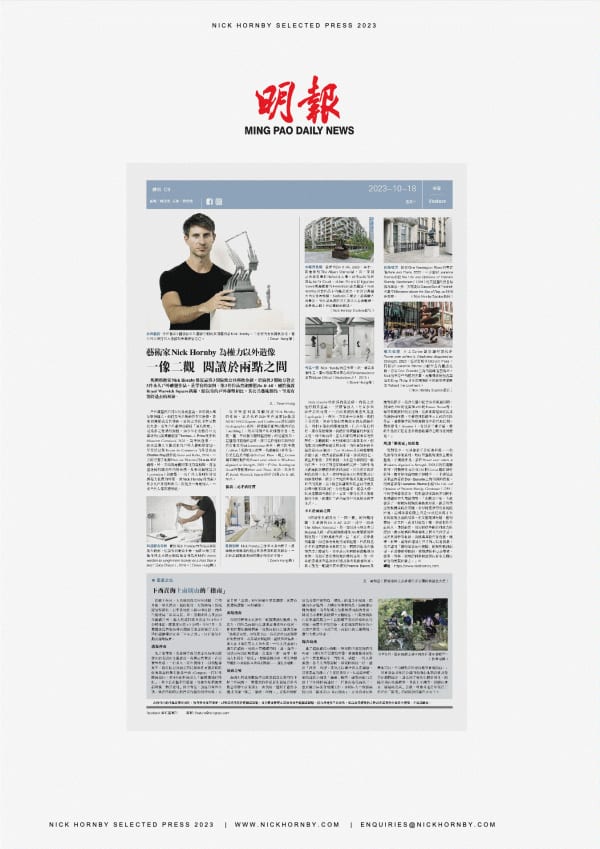
Ming Pao Daily: Nick Hornby creates images beyond power – Dawn Hung
Ming Pao Daily, October 18, 2023 -
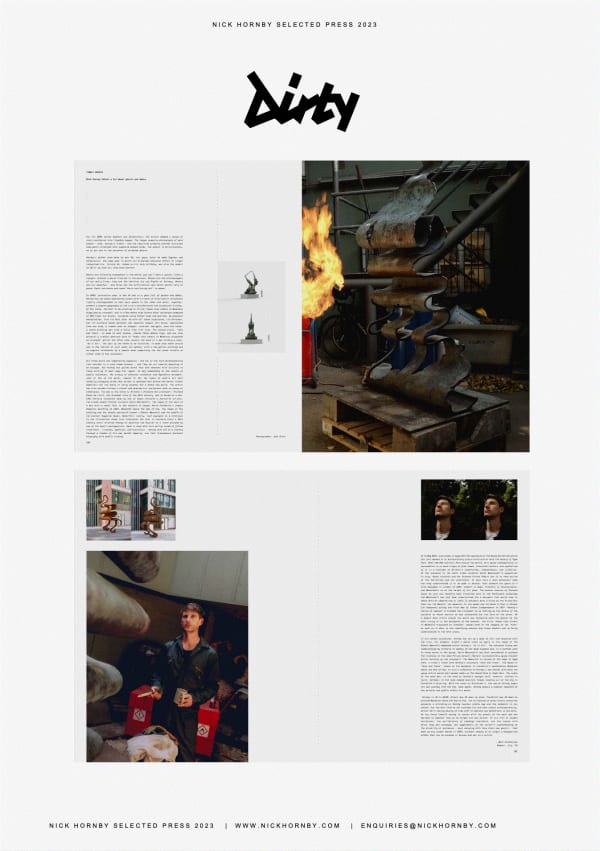
Dirty Magazine: Timely Ghosts – Mort Chatterjee
Dirty Magazine, October 1, 2023 -

House & Garden: Art Scene – Fiona McKenzie Johnston
House & Garden, October 1, 2023 -

The Londonist: Three new Morphing Sculptures – Matt Brown
MATT BROWN, The Londonist, September 28, 2023 -

Times Radio: Nick Hornby interviewed by Ed Vaizey
Times Radio, September 22, 2023 -

BBC News Feature
September 21, 2023 -

Artlyst: Interview of the Month – Paul Carey-Kent
Paul Carey-Kent, Artlyst, August 1, 2023 -
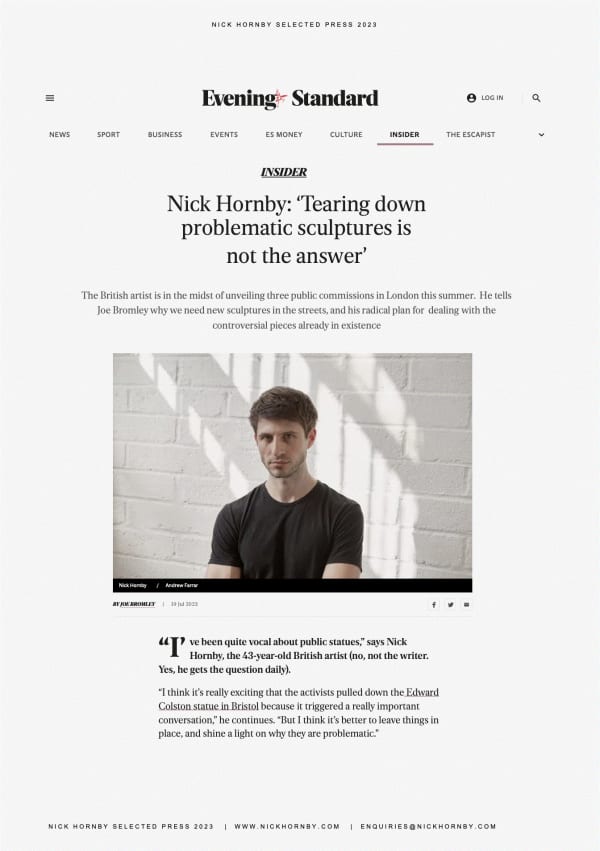
Evening Standard: Tearing down problematic sculptures... – Joe Bromley
Joe Bromley, Evening Standard, July 19, 2023 -
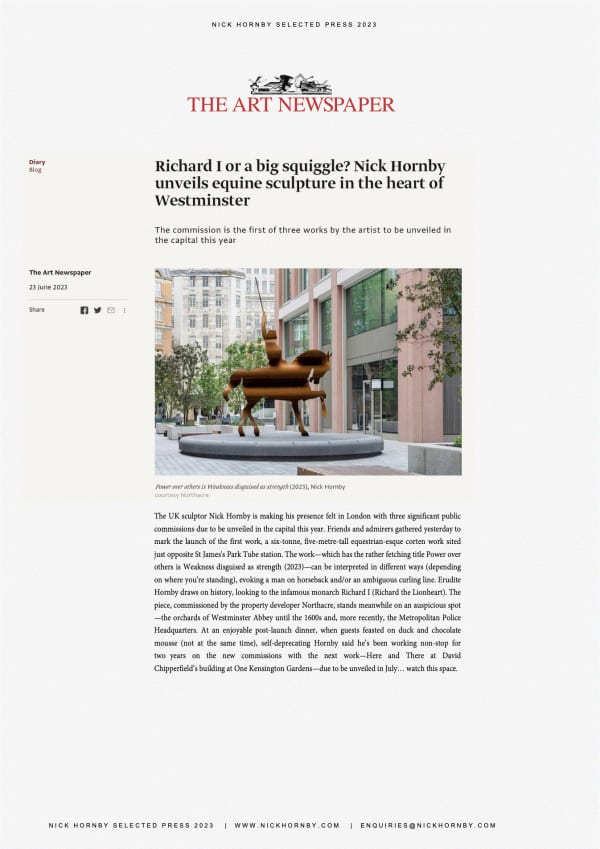
The Art Newspaper: Nick Hornby unveils equine sculpture...
The Art Newspaper, June 23, 2023 -
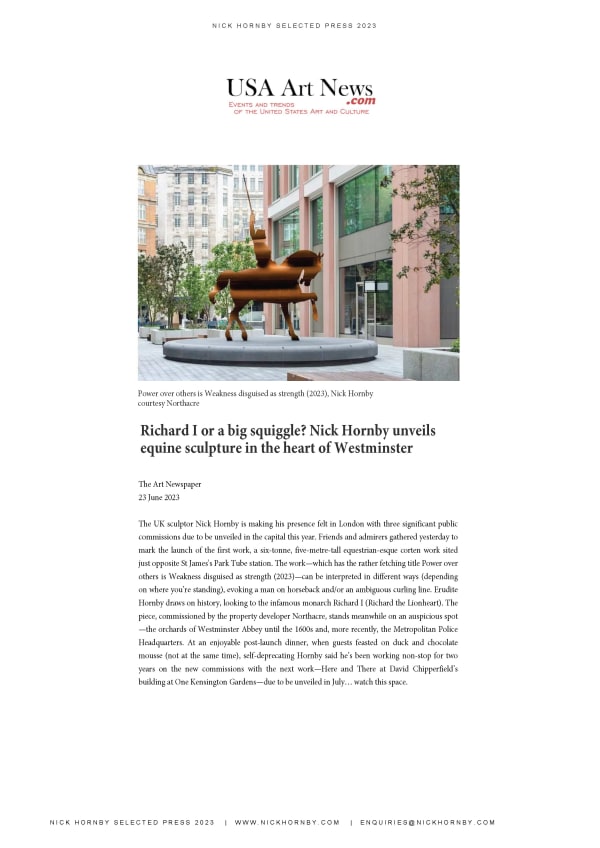
USA Art News: Nick Horny unveils equine sculpture in the heart of Westminster
USA Art News, June 23, 2023 -

BBC Radio London: Nick Hornby interviewed by Lionheart
BBC Radio London, June 23, 2023 -
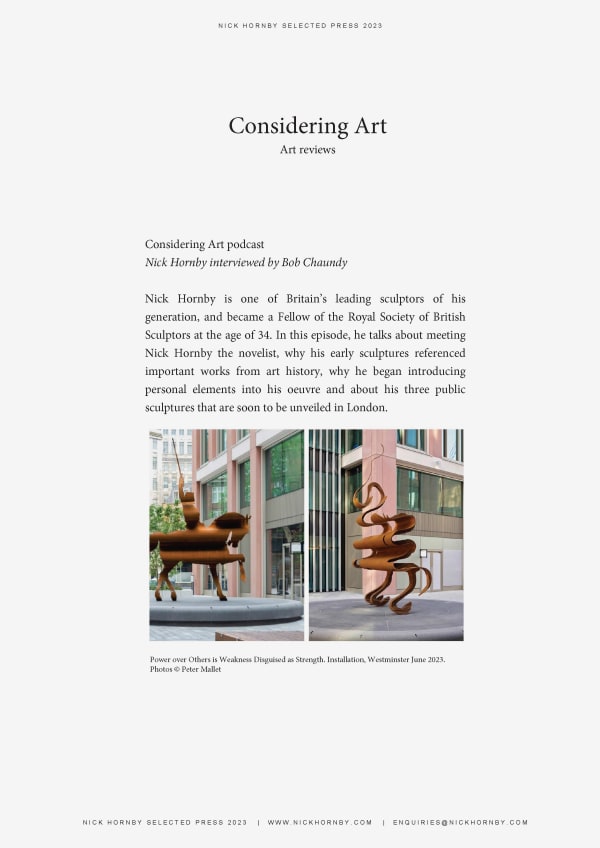
Considering Art Podcast: Nick Hornby Sculptor – Bob Chaundy
Bob Chaundy, ConsideringArt.com, June 19, 2023 -

The Telegraph: Artistic Mettle – Russell Sach
Russell Sach, The Telegraph, April 10, 2023 -
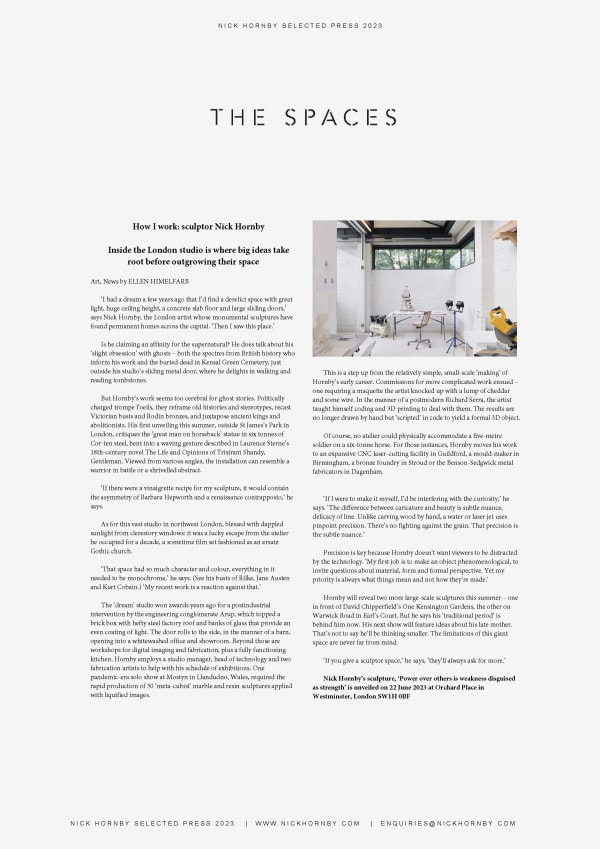
The Spaces: How I work – Ellen Himelfarb
Ellen Himelfarb, thespaces.com





